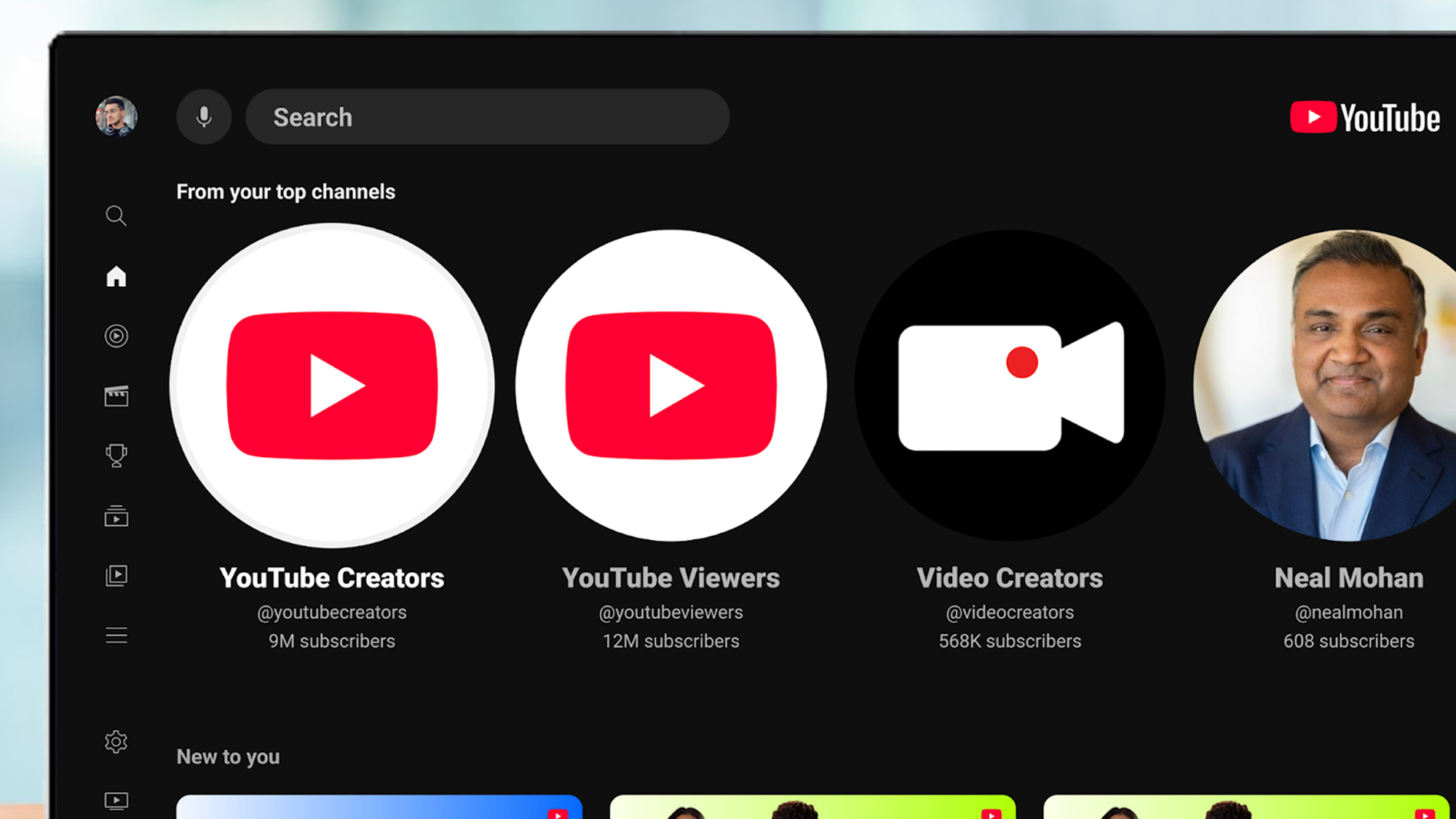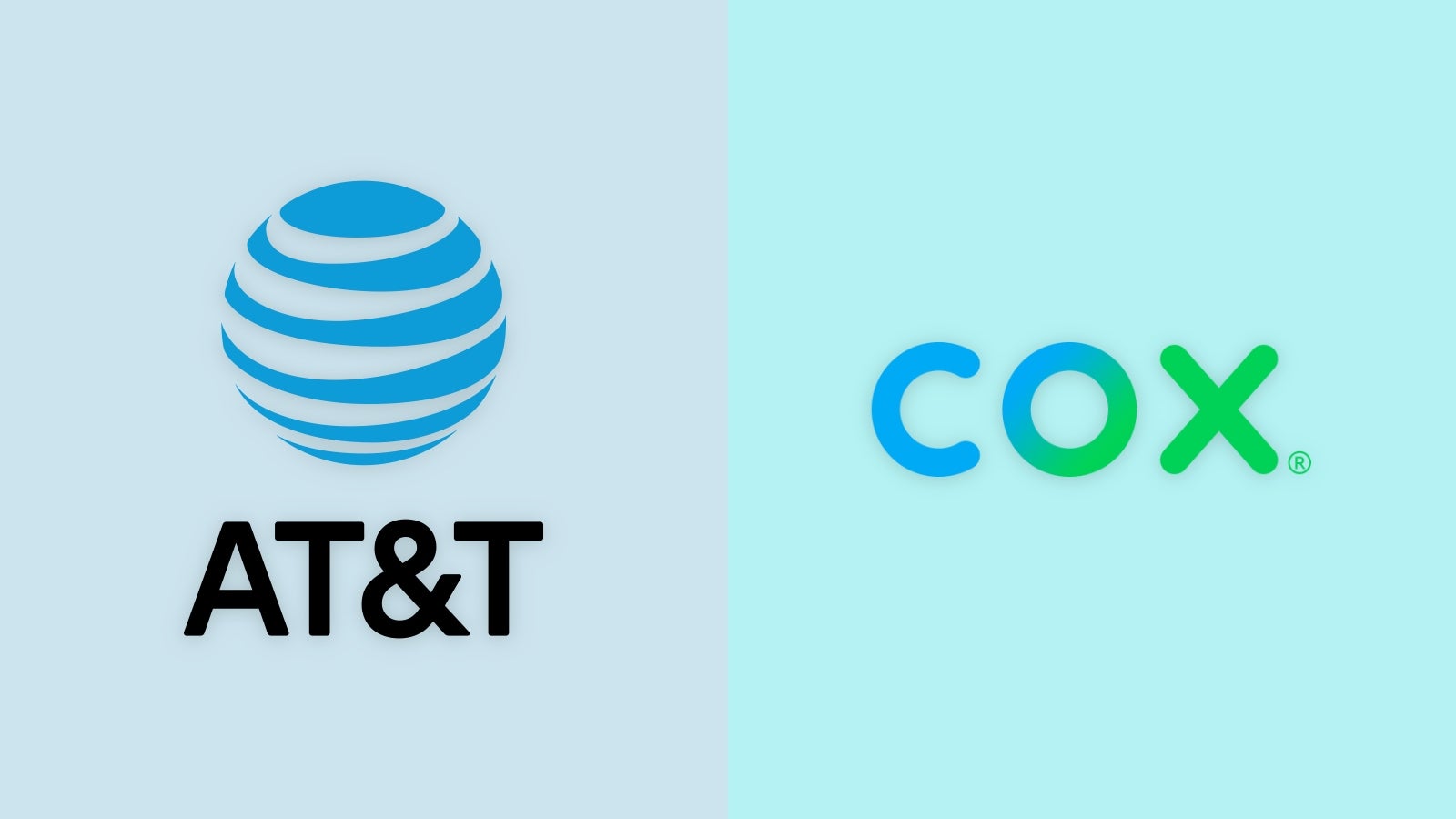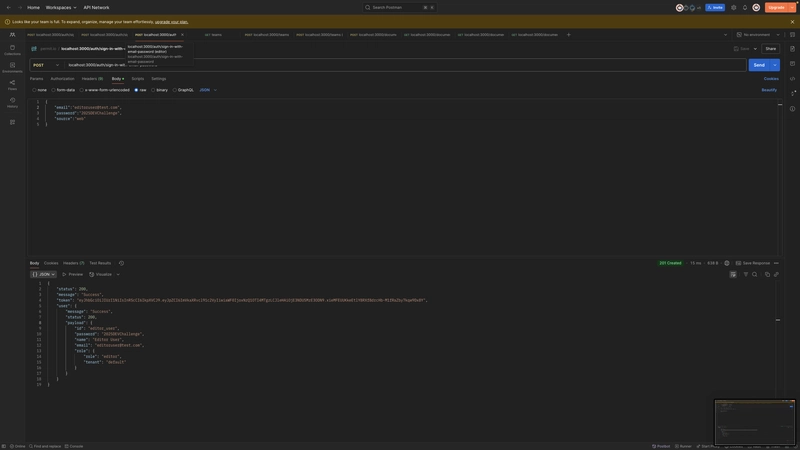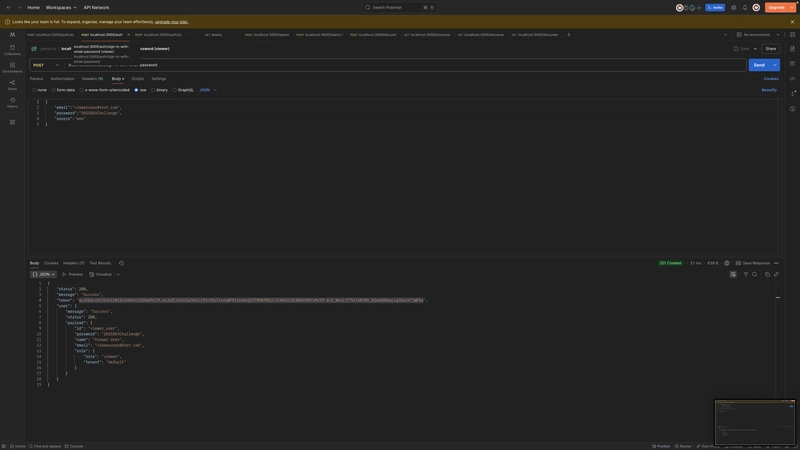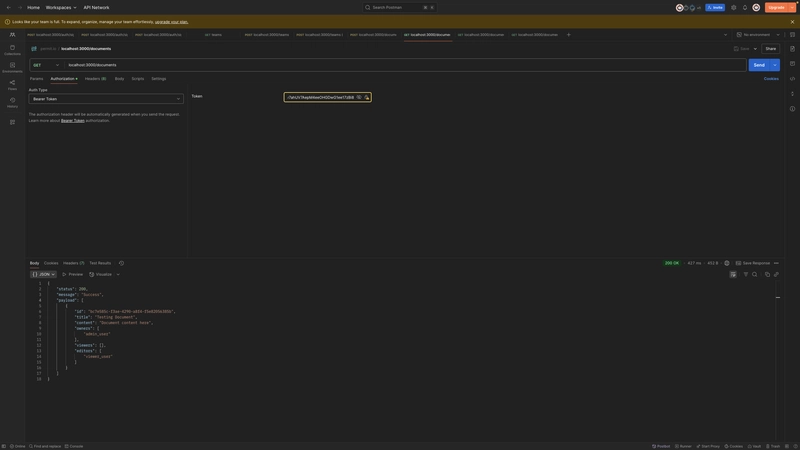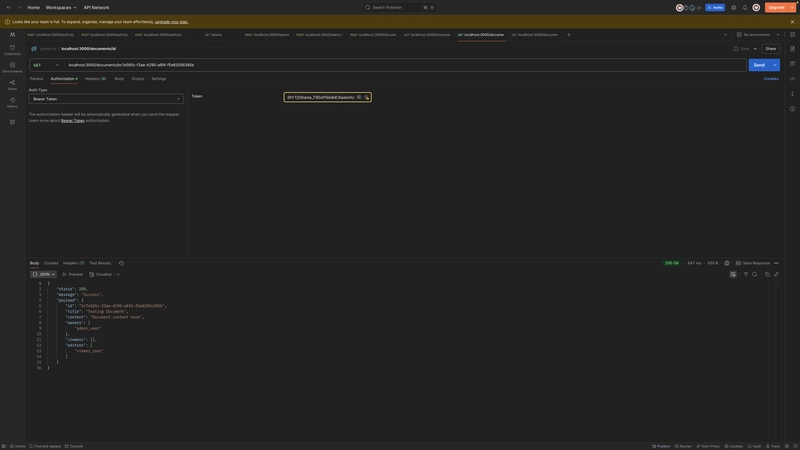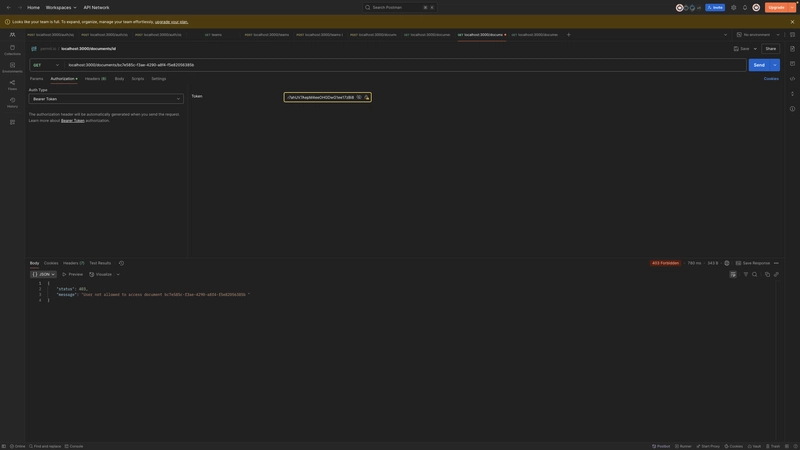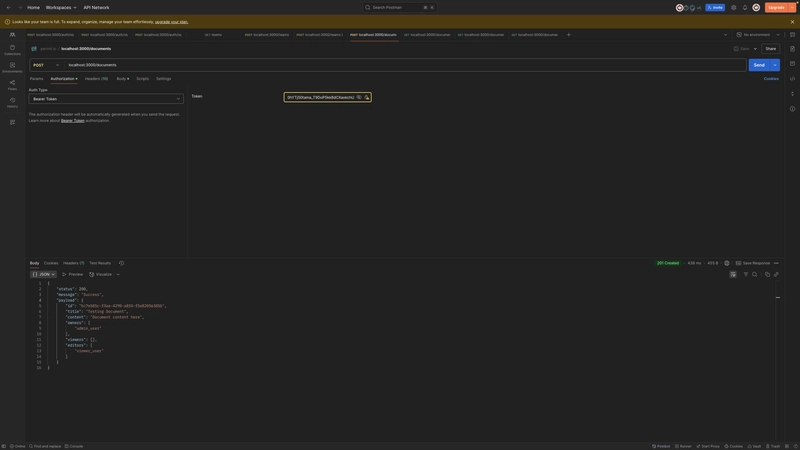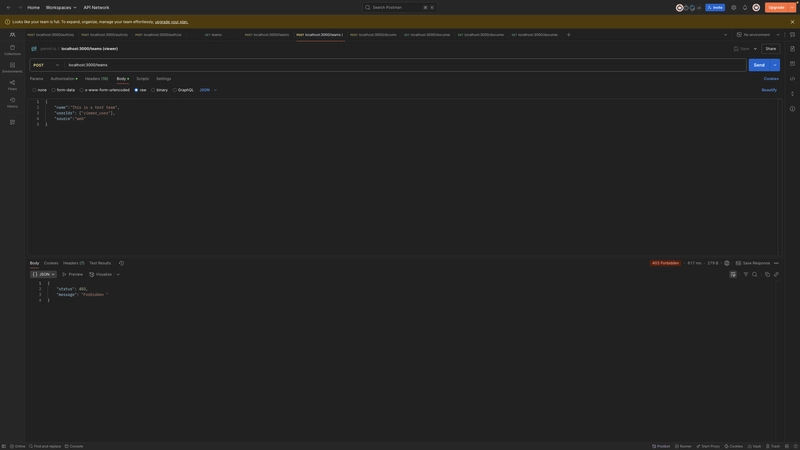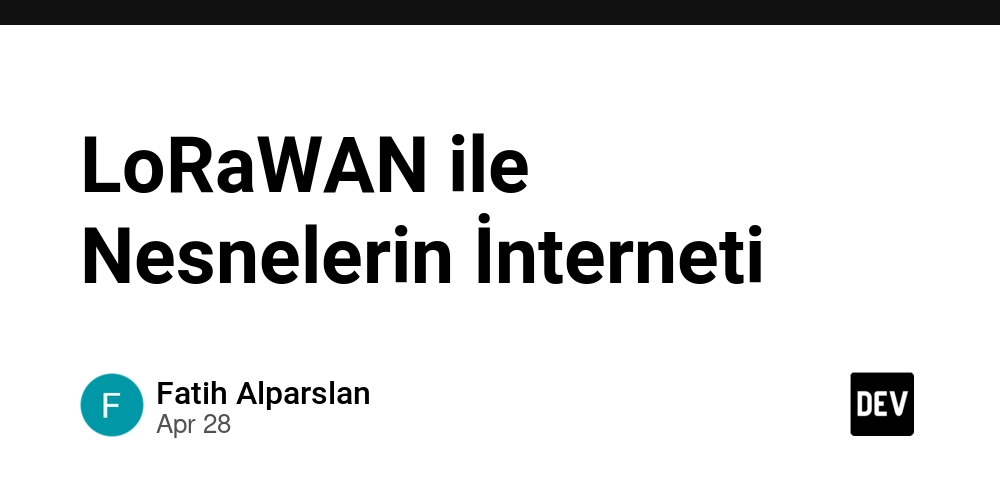Permit IO Auth Challenge: Document and Team Management API with Fine-Grained Access Control
This is a submission for the Permit.io Authorization Challenge: API-First Authorization Reimagined What I Built I built a Document and Team Management API using NestJS that elegantly implements API-first authorization using Permit.io. This application goes beyond basic CRUD operations by demonstrating real-world access control scenarios for documents (viewing, editing, owning) and teams (viewing, creating, managing members). The core problem it solves is providing a secure and flexible way to manage access to sensitive resources in a multi-user environment, where permissions are not hardcoded but dynamically enforced based on external policies and attributes managed by Permit.io. This allows for a more scalable, auditable, and maintainable authorization system. Demo While a live deployment isn't currently available for this challenge submission, I have created a comprehensive Postman collection (permit.io.postman_collection.json in the project repository) that demonstrates the functionality of all API endpoints and the enforced authorization rules. Additionally, the detailed API documentation in the README provides clear request/response examples showcasing the different access control scenarios. Login as an admin Login as an editor Login as a viewer Get all documents (allowed access) ABAC - Get specific document (allowed access) ABAC - Get specific document (disallowed access) RBAC - Create team (allowed access) RBAC - Create team (disallowed access) Project Repo https://github.com/TylerMutai/permit.io-auth-challenge Be sure to check out the README.md file in the repository for detailed installation instructions, environment variable setup, architectural overview, a comprehensive guide to implementing RBAC and ABAC using permit.io and a description of the API endpoints and their authorization mechanisms. My Journey My journey involved several key steps: Understanding the Challenge and Permit.io: I first thoroughly reviewed the challenge requirements and the Permit.io documentation, focusing on API-first authorization principles. Considering I wanted to also implement Attribute-Bases Access Control, I had to recognize the capabilities of both the Cloud and Container PDP, which pushed me to opt for the Container PDP route since the Cloud PDP doesn't yet support ABAC. Choosing the Domain: I selected document and team management as a practical domain with clear authorization needs. Documents can have different access levels (inspired by how Google Docs works): view, edit and ownership, which was a perfect attack vector for showcasing ABAC, and teams which would help showcase traditional Role-Based Access Control. Setting up the NestJS API: I scaffolded a NestJS application, implementing user authentication, which involved setting up necessary mechanisms for securing endpoints and obtaining the logged-in user, and designed the API endpoints for documents and teams, focusing on clear REST conventions. Integrating Permit.io: This was the core of the challenge. I implemented the Permit.io client within the NestJS application to communicate with the PDP. I focused on: Resource and Action Definitions: Defining the resource types (document, team) and the actions that can be performed on them (view, create, update, delete, readone). Attribute Handling: Implementing logic to fetch relevant user and resource attributes to be passed to Permit.io for ABAC. For example, implementing role-based access for certain document endpoints, and all teams endpoints, and attribute-based access for fetching a single document. This also involved implementing helper guards and decorators (in cases for permissions and authorization) that allowed me to easily obtain the logged-in user object and do permission validation and access control in a maintainable and re-usable way. Authorization Checks: Integrating Permit.io's check function within my API endpoint controllers to verify if the authenticated user has the required permission for the requested action on the specific resource. Error Handling: Ensuring that all responses are standardized (by using http exception filters), even when errors are thrown. Implementing Attribute-Based Access Control (ABAC): I specifically chose to use the Container PDP to demonstrate ABAC (again, since the cloud PDP doesn't support this). This involved an additional challenge (which I really didn't mind), of deploying their docker container onto cloud run. This journey helped me learn additional concepts on how cloud run works (and min-max instances importance, and what and OPA is -)). This also involved thinking about how attributes of users (e.g., roles), resources (e.g., documents and teams), and the relationships between them could influence authorization decisions defined in Permit.io policies. Documentation: Throughout the development proce
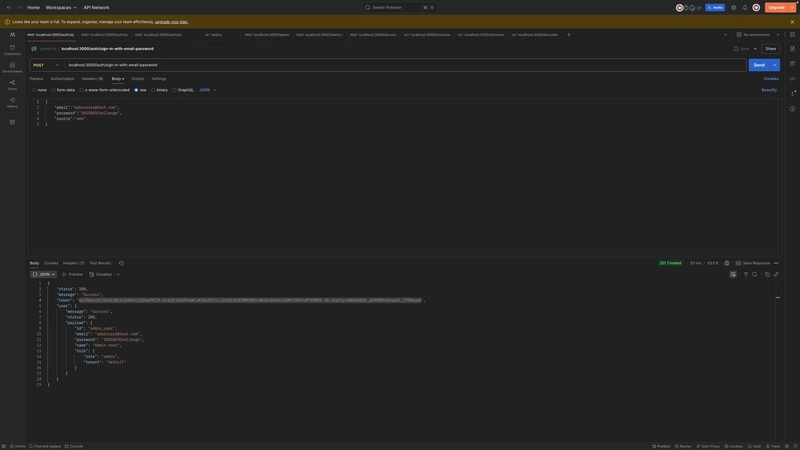
This is a submission for the Permit.io Authorization Challenge: API-First Authorization Reimagined
What I Built
I built a Document and Team Management API using NestJS that elegantly implements API-first authorization using Permit.io. This application goes beyond basic CRUD operations by demonstrating real-world access control scenarios for documents (viewing, editing, owning) and teams (viewing, creating, managing members). The core problem it solves is providing a secure and flexible way to manage access to sensitive resources in a multi-user environment, where permissions are not hardcoded but dynamically enforced based on external policies and attributes managed by Permit.io. This allows for a more scalable, auditable, and maintainable authorization system.
Demo
While a live deployment isn't currently available for this challenge submission, I have created a comprehensive Postman collection (permit.io.postman_collection.json in the project repository) that demonstrates the functionality of all API endpoints and the enforced authorization rules. Additionally, the detailed API documentation in the README provides clear request/response examples showcasing the different access control scenarios.
Login as an admin
Login as an editor
Login as a viewer
Get all documents (allowed access)
ABAC - Get specific document (allowed access)
ABAC - Get specific document (disallowed access)
RBAC - Create team (allowed access)
RBAC - Create team (disallowed access)
Project Repo
https://github.com/TylerMutai/permit.io-auth-challenge
Be sure to check out the README.md file in the repository for detailed installation instructions, environment variable setup, architectural overview, a comprehensive guide to implementing RBAC and ABAC using permit.io and a description of the API endpoints and their authorization mechanisms.
My Journey
My journey involved several key steps:
Understanding the Challenge and Permit.io: I first thoroughly reviewed the challenge requirements and the Permit.io documentation, focusing on API-first authorization principles. Considering I wanted to also implement Attribute-Bases Access Control, I had to recognize the capabilities of both the Cloud and Container PDP, which pushed me to opt for the Container PDP route since the Cloud PDP doesn't yet support ABAC.
Choosing the Domain: I selected document and team management as a practical domain with clear authorization needs. Documents can have different access levels (inspired by how Google Docs works): view, edit and ownership, which was a perfect attack vector for showcasing ABAC, and teams which would help showcase traditional Role-Based Access Control.
Setting up the NestJS API: I scaffolded a NestJS application, implementing user authentication, which involved setting up necessary mechanisms for securing endpoints and obtaining the logged-in user, and designed the API endpoints for documents and teams, focusing on clear REST conventions.
-
Integrating Permit.io: This was the core of the challenge. I implemented the Permit.io client within the NestJS application to communicate with the PDP. I focused on:
- Resource and Action Definitions: Defining the resource types (document, team) and the actions that can be performed on them (view, create, update, delete, readone).
- Attribute Handling: Implementing logic to fetch relevant user and resource attributes to be passed to Permit.io for ABAC. For example, implementing role-based access for certain document endpoints, and all teams endpoints, and attribute-based access for fetching a single document. This also involved implementing helper guards and decorators (in cases for permissions and authorization) that allowed me to easily obtain the logged-in user object and do permission validation and access control in a maintainable and re-usable way.
-
Authorization Checks: Integrating Permit.io's
checkfunction within my API endpoint controllers to verify if the authenticated user has the required permission for the requested action on the specific resource. - Error Handling: Ensuring that all responses are standardized (by using http exception filters), even when errors are thrown.
Implementing Attribute-Based Access Control (ABAC): I specifically chose to use the Container PDP to demonstrate ABAC (again, since the cloud PDP doesn't support this). This involved an additional challenge (which I really didn't mind), of deploying their docker container onto cloud run. This journey helped me learn additional concepts on how cloud run works (and min-max instances importance, and what and OPA is -)). This also involved thinking about how attributes of users (e.g., roles), resources (e.g., documents and teams), and the relationships between them could influence authorization decisions defined in Permit.io policies.
Documentation: Throughout the development process, I prioritized clear and comprehensive documentation in the README. This included setup instructions, environment variable explanations, the architectural overview of the API, a comprehensive guide to implementing RBAC and ABAC using permit.io, and detailed API endpoint descriptions with request/response examples.
Challenges and Overcoming Them:
- Deploying the Container PDP: Initially, grasping the nuances of setting up and querying the Container PDP required in-depth digging into the permit.io documentation on how to do this. Considering that I was also deploying this to Google Cloud (using Cloud Run), this involved looking up more documentation on defining ports correctly, environment variables etc. I was then eventually able to deploy the Container PDP to cloud run.
- Understanding ABAC: Initially, grasping the nuances of setting up and querying ABAC required careful review of the Permit.io documentation. I spent time understanding how to structure attributes and policies on the permit.io dashboard, how to sync users (and what their unique identifier is), and lastly, I had to experiment (and comb the documentation) on how to pass attributes as request parameters onto permit.io.
- Designing Meaningful Policies: Crafting Permit.io policies that accurately reflected the desired access control logic for documents and teams required some iteration. I focused on creating policies that were both functional and easy to understand.
- Integrating Permit.io Client: Ensuring the Permit.io client was correctly initialized and used within the NestJS controllers to perform authorization checks required careful attention to the SDK documentation and examples. I also preferred deploying the permit.io pdp on Cloud Run, which involved combing in deeper into the documentation to further understand how to set up the client (part of the SDK) to point to the correct PDP url.
What I Learned:
- The power and elegance of externalized authorization using tools like Permit.io. It significantly decouples authorization logic from the core application, making it more maintainable and scalable. I didn't have to implement RBAC logic in code, hard-code new permissions in my codebase (which really saved on time, allowing me to focus on logic, and also new deployments everytime a new feature, hence a new permission, is introduced!), and therefore iterations were instant, rather than having to wait for a new deployment to have the changes effected (similar to how feature flags work, which was quite neat-)).
- The benefits of API-first thinking in designing authorization systems. By treating authorization as a fundamental aspect of the API design, it ensures security is baked in from the start.
- The concepts and practical implementation of Attribute-Based Access Control (ABAC) and its potential for fine-grained access control (this was a new concept for me, which took sometime understanding, but was quite fascinating to see in action).
API-First Authorization
Permit.io was central to building an API-first authorization system in this project. Here's how it was implemented:
External Decision Point: Instead of embedding authorization logic within the NestJS application code (e.g., handling roles and permissions logic within the backend code), all authorization decisions are delegated to the external Permit.io Policy Decision Point (PDP). The API acts as a Policy Enforcement Point (PEP), querying the PDP to determine if a user is authorized to perform a specific action on a resource.
Declarative Policies: The access control rules for documents and teams are defined declaratively as policies within the Permit.io platform (or would be in a real-world scenario connected to the cloud or a configured Container PDP). These policies specify who can perform which actions on which resources, often based on roles, attributes, and relationships.
Centralized Management: Permit.io provides a centralized platform for managing and auditing authorization policies. This allows for easier updates to access control rules without requiring code changes in the API.
Abstraction of Authorization Logic: The API code remains focused on its core business logic (managing documents and teams). The complexities of authorization are abstracted away and handled by Permit.io. The API simply needs to make authorization requests and enforce the PDP's decisions.
Attribute-Based Access Control (ABAC) Implementation: By utilizing the Container PDP (since ABAC is not supported by the cloud PDP), the project demonstrates ABAC. When an API request is made, the application gathers relevant attributes of the user making the request and the resource being accessed (e.g., the user's ID, the document's owner, editor and viewer IDs). These attributes are then sent to Permit.io, which evaluates them against the defined ABAC policies to make an authorization decision. For example, I implemented a policy which stated that a user can edit a document if their ID is present in the document's
editorsorownersattribute.
In essence, this project treats authorization as a distinct layer that the API interacts with. The API doesn't know nor handle the specific rules and authorization logic; it only knows how to ask Permit.io (which handles the rules and auth logic) if an action is allowed. This aligns perfectly with the principles of API-first authorization, where security is handled through a dedicated and externalized system.































![[Free Webinar] Guide to Securing Your Entire Identity Lifecycle Against AI-Powered Threats](https://blogger.googleusercontent.com/img/b/R29vZ2xl/AVvXsEjqbZf4bsDp6ei3fmQ8swm7GB5XoRrhZSFE7ZNhRLFO49KlmdgpIDCZWMSv7rydpEShIrNb9crnH5p6mFZbURzO5HC9I4RlzJazBBw5aHOTmI38sqiZIWPldRqut4bTgegipjOk5VgktVOwCKF_ncLeBX-pMTO_GMVMfbzZbf8eAj21V04y_NiOaSApGkM/s1600/webinar-play.jpg?#)






































































































































![[The AI Show Episode 145]: OpenAI Releases o3 and o4-mini, AI Is Causing “Quiet Layoffs,” Executive Order on Youth AI Education & GPT-4o’s Controversial Update](https://www.marketingaiinstitute.com/hubfs/ep%20145%20cover.png)













































































































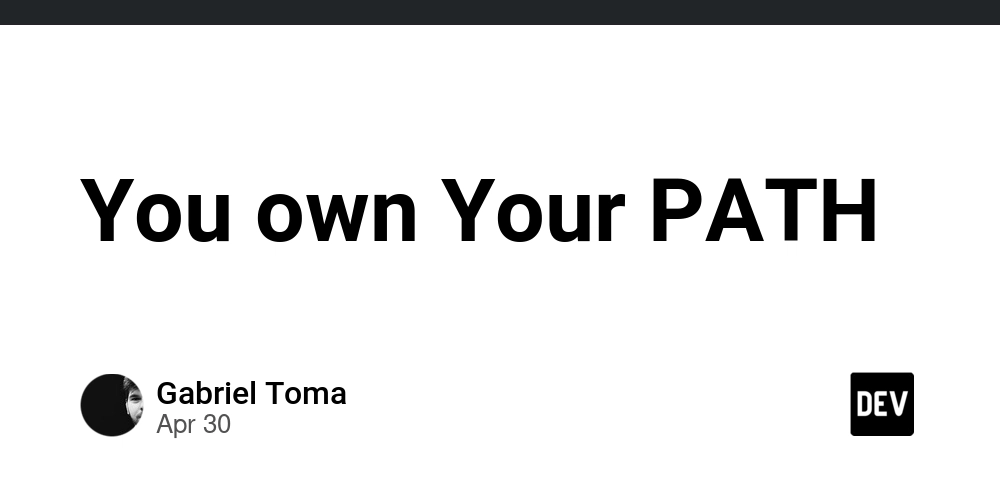



























































































































































_Jochen_Tack_Alamy.png?width=1280&auto=webp&quality=80&disable=upscale#)

















































































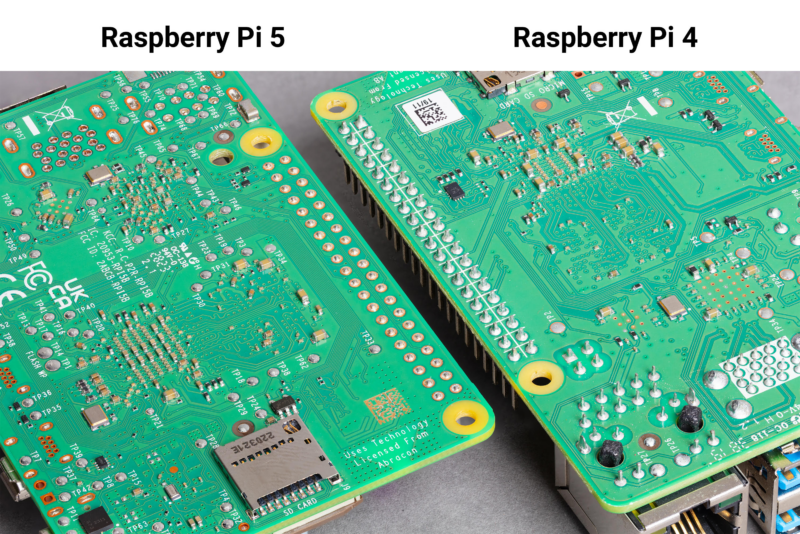



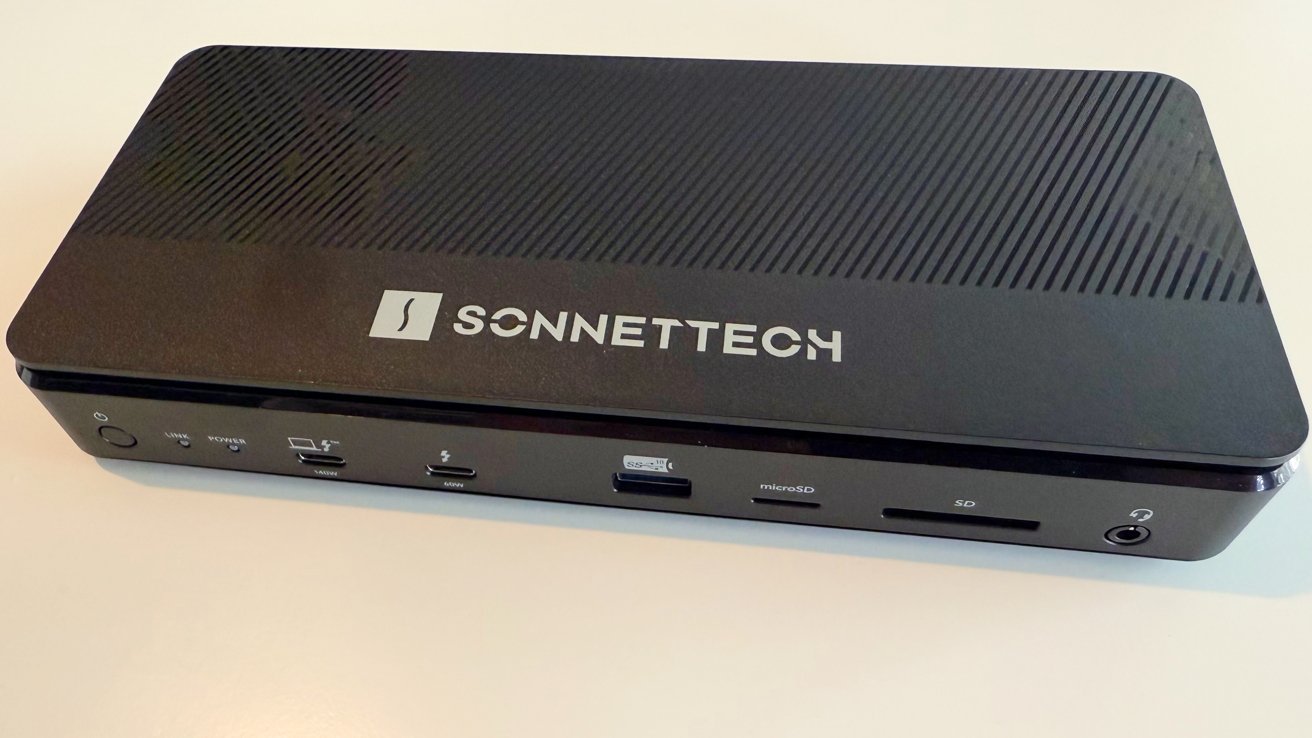



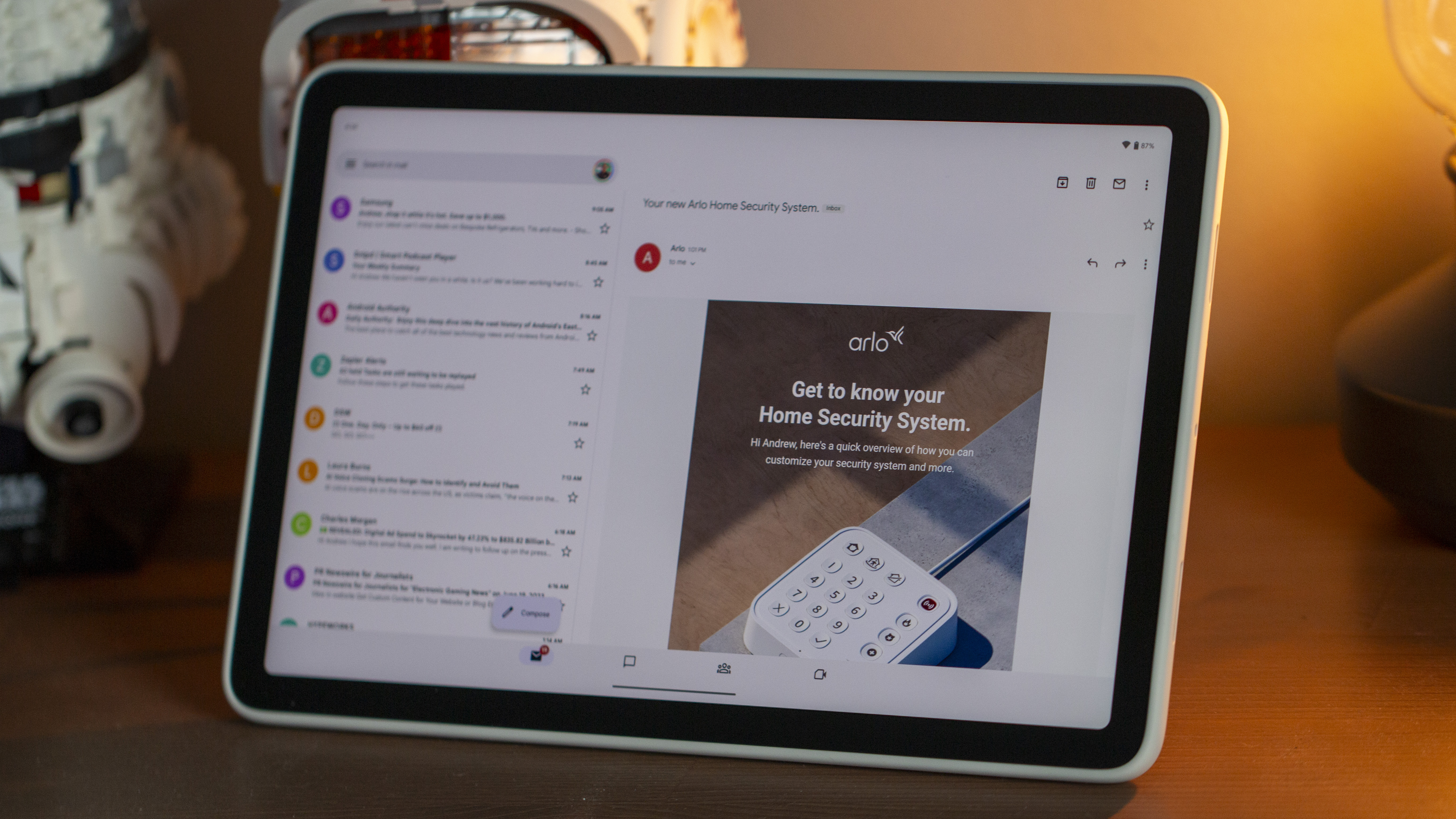








![Apple testing Stage Manager for iPhone, Photographic Styles for video, and more [Video]](https://i0.wp.com/9to5mac.com/wp-content/uploads/sites/6/2025/04/iOS-Decoded-iOS-18.5.jpg?resize=1200%2C628&quality=82&strip=all&ssl=1)















![New Hands-On iPhone 17 Dummy Video Shows Off Ultra-Thin Air Model, Updated Pro Designs [Video]](https://www.iclarified.com/images/news/97171/97171/97171-640.jpg)
![Apple Shares Trailer for First Immersive Feature Film 'Bono: Stories of Surrender' [Video]](https://www.iclarified.com/images/news/97168/97168/97168-640.jpg)
![Apple Restructures Global Affairs and Apple Music Teams [Report]](https://www.iclarified.com/images/news/97162/97162/97162-640.jpg)
















